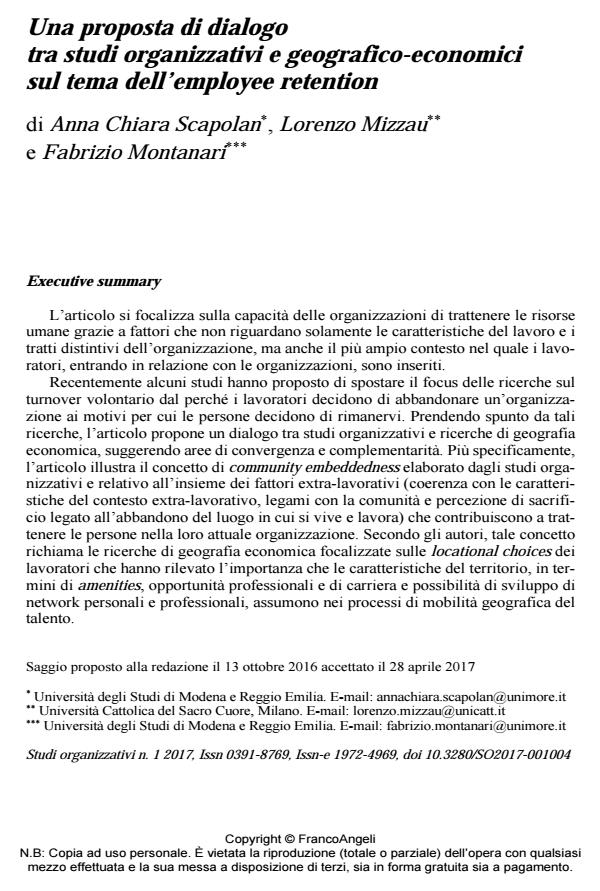Una proposta di dialogo tra studi organizzativi e geografico-economici sul tema dell’employee retention
Titolo Rivista STUDI ORGANIZZATIVI
Autori/Curatori Anna Chiara Scapolan, Lorenzo Mizzau, Fabrizio Montanari
Anno di pubblicazione 2017 Fascicolo 2017/1
Lingua Italiano Numero pagine 21 P. 89-109 Dimensione file 239 KB
DOI 10.3280/SO2017-001004
Il DOI è il codice a barre della proprietà intellettuale: per saperne di più
clicca qui
Qui sotto puoi vedere in anteprima la prima pagina di questo articolo.
Se questo articolo ti interessa, lo puoi acquistare (e scaricare in formato pdf) seguendo le facili indicazioni per acquistare il download credit. Acquista Download Credits per scaricare questo Articolo in formato PDF

FrancoAngeli è membro della Publishers International Linking Association, Inc (PILA)associazione indipendente e non profit per facilitare (attraverso i servizi tecnologici implementati da CrossRef.org) l’accesso degli studiosi ai contenuti digitali nelle pubblicazioni professionali e scientifiche
L’articolo si focalizza sulla capacità delle organizzazioni di trattenere le risorse umane grazie a fattori che non riguardano solamente le caratteristiche del lavoro e i tratti distintivi dell’organizzazione, ma anche il più ampio contesto nel quale i lavoratori, entrando in relazione con le organizzazioni, sono inseriti. Recentemente alcuni studi hanno proposto di spostare il focus delle ricerche sul turnover volontario dal perché i lavoratori decidono di abbandonare un’organizzazione ai motivi per cui le persone decidono di rimanervi. Prendendo spunto da tali ricerche, l’articolo propone un dialogo tra studi organizzativi e ricerche di geografia economica, suggerendo aree di convergenza e complementarità. Più specificamente, l’articolo illustra il concetto di community embeddedness elaborato dagli studi organizzativi e relativo all’insieme dei fattori extra-lavorativi (coerenza con le caratteristiche del contesto extra-lavorativo, legami con la comunità e percezione di sacrificio legato all’abbandono del luogo in cui si vive e lavora) che contribuiscono a trattenere le persone nella loro attuale organizzazione. Secondo gli autori, tale concetto richiama le ricerche di geografia economica focalizzate sulle locational choices dei lavoratori che hanno rilevato l’importanza che le caratteristiche del territorio, in termini di amenities, opportunità professionali e di carriera e possibilità di sviluppo di network personali e professionali, assumono nei processi di mobilità geografica del talento. In sintesi, l’articolo evidenzia una sostanziale convergenza degli studi organizzativi e geografico-economici nel sottolineare la rilevanza di fattori extra-lavorativi legati alle caratteristiche del contesto urbano e al senso di radicamento nella comunità nello spiegare la capacità di retention delle organizzazioni. Inoltre, gli studi sviluppati all’interno delle due discipline risultano complementari nel suggerire come l’interazione positiva tra il radicamento nell’organizzazione (organizational embeddeness) e la community embeddedness possa fornire interessanti spunti per la ricerca futura e utili implicazioni manageriali per aziende e policy makers. In particolare, indagare il ruolo svolto dai fattori extra-lavorativi e in particolare di relazioni e "spazi" nella comunità, che influenzano la community embeddedness sembra costituire una promettente linea di ricerca futura per gli studi organizzativi sulla retention. Le principali implicazioni manageriali riguardano come le aziende e le istituzioni locali possano dialogare, interagire e collaborare per aumentare il livello di radicamento delle persone sia dentro che fuori le organizzazioni, con benefici in termini di maggiore soddisfazione dei lavoratori e dei cittadini, e conseguentemente minore turnover e maggiore capacità di retention, per organizzazioni e città.
Parole chiave:Embeddedness, turnover, ritenzione, gestione delle risorse umane, geografia economica.
- Rethinking Work: Pathways and Practices in Business and Society. Introduction to the Special Issue. Luigi Moschera, Mario Pezzillo Iacono, Giovanna Lo Nigro, Laura Lucia Parolin, in STUDI ORGANIZZATIVI 2/2019 pp.9
DOI: 10.3280/SO2018-002001 - The Role of Solidarity in Diversity Management Practices: A Challenge for Social Innovation in Organisations Davide Bizjak, Guglielmo Faldetta, Luigi Maria Sicca, in STUDI ORGANIZZATIVI 2/2019 pp.130
DOI: 10.3280/SO2018-002006 - An aesthetic account of space: A report on recent developments in organizational research Federica De Molli, in STUDI ORGANIZZATIVI 1/2019 pp.38
DOI: 10.3280/SO2019-001002
Anna Chiara Scapolan, Lorenzo Mizzau, Fabrizio Montanari, Una proposta di dialogo tra studi organizzativi e geografico-economici sul tema dell’employee retention in "STUDI ORGANIZZATIVI " 1/2017, pp 89-109, DOI: 10.3280/SO2017-001004